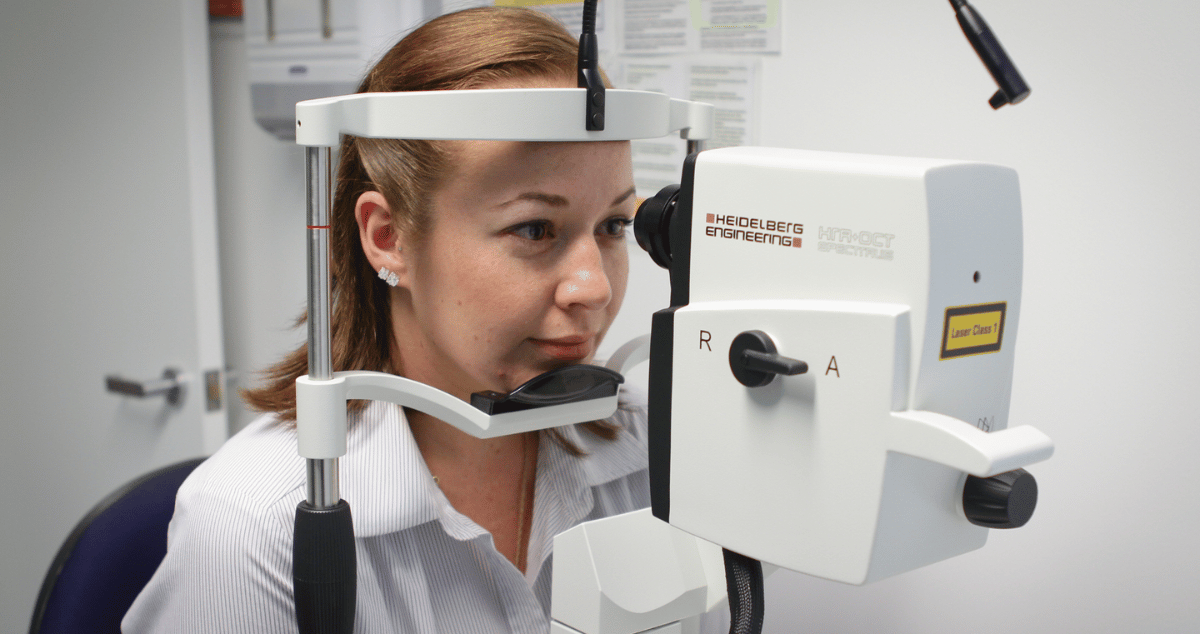Share
Optometrist, Miss Amy Yu, recently took part in a Live Q&A with Glaucoma Australia where she answered some of the most commonly asked questions about glaucoma tests.

What sort of tests are involved in diagnosing glaucoma?
Measurement of eye pressure, bilateral computerised perimetry (visual fields testing), and imaging of the optic nerve with optical coherence tomography (OCT). Those three things in combination will help us determine a diagnosis of glaucoma.
Why do patients keep repeating the OCT and the visual field test and how often should they be done?
Repetition is key. Usually the first couple of times, the results aren't reliable unfortunately and that's just part of the learning curve. Repetition is good just to make sure that the results are consistent. As for how often, it would depend on how severe it is. If I’m unsure about about a glaucoma diagnosis, I’d say around every 6 months, and 12 months if it's not as suspicious.
What is the difference between the glaucoma field test and the binocular driving visual field test?
With the glaucoma field test, you test one eye at a time as we check for glaucoma, which usually begins as a unilateral disease. The binocular driving visual field test assesses both eyes at the same time since you drive with both eyes open.
My vision is always the same and my glasses script has not changed – does that mean my glaucoma is stable?
Not necessarily. Glaucoma tends to affect your side vision first. The part of your vision that glasses aims to correct is generally your central vision, which involves the macula rather than the optic nerve. Your glasses could still be working great and that might not prompt you to go back to your optometrist. However, that doesn't mean the glaucoma is stable. We still need to do those extra tests every time just to make sure it's not getting worse. So yes, I would encourage you to visit the optometrist at the recommended schedule just to make sure things are stable.
Why do patients need to repeat tests at the ophthalmologist after only recently seeing the optometrist?
Sometimes, the ophthalmologists have slightly different machines and they like to have their own baseline as well. If requested, patients can actually ask their optometrist to send the results over to their ophthalmologist if they don't wish to repeat the tests again. Optometrists are more than happy to attach the OCT reports and the visual field reports to the referral so that they have a record of what's been done and can save a bit of testing time.
How do the different methods of eye pressure tests differ? Which is the best one for glaucoma?
The best one for glaucoma is the one where we put anaesthetic and the probe on your eye. This is called contact tonometry and it is our gold standard. Most specialists still tend to use this, however in busy practices unfortunately it's just not practical. It’s not a very time efficient way of churning out eye pressures so unfortunately, we have to go with the non-contact version, where you feel an air puff go into your eye. If we do suspect things like abnormally higher eye pressures, we go ahead and measure the corneal thickness. If the corneas tend to be on the thicker side, it will tend to artificially elevate your eye pressures and vice versa, if the corneal thicknesses are a bit lower than your eye pressures may be slightly underestimated.
Do optometrists routinely check the angles of the eyes?
So, me personally yes. There are a few ways to check the angles of the eyes. The most common and quickest method is using the microscope that we've got with the light on it called the slit lamp. Another way they can do it is anaesthetising the eye and putting a hand-held contact lens called a gonioscope on your eye. This is definitely a more invasive way but it's a very detailed way of checking these structures inside the eye. That's something that you can't actually see front on - you actually have to look inside with the lens. I will only do this when indicated such as in cases of suspected angle closure, where the eye pressures have spiked dramatically. Usually, these cases require an urgent referral to an eye specialist anyway who has a bit more expertise in doing the more invasive tests.
Is the puffer machine used by eye specialists as accurate as a tonometer for reading eye pressures?
With the puffer machine, there are variations between machines. The reading can also be affected if the patient does tend to squint, is anxious or hold their breath. This can also artificially raise the eye pressure as well. So I wouldn't say it's the most accurate but it's the most time efficient. The tonometer I assume we're talking about is the contact one. That generally is the more gold standard and therefore more accurate. But in terms of managing a larger practice with a lot of patients, the puffer machine is the most effective way of going about it.
Can glaucoma tests detect macular degeneration and also the other way around?
The OCT machine, which scans through the optic nerve to check for glaucoma, can actually detect macular degeneration because when we take the photo it actually goes through the middle part of the eye (macula) as well. The management is slightly different between the two however.
If you would like to watch the recording of this Live Q&A click here.



